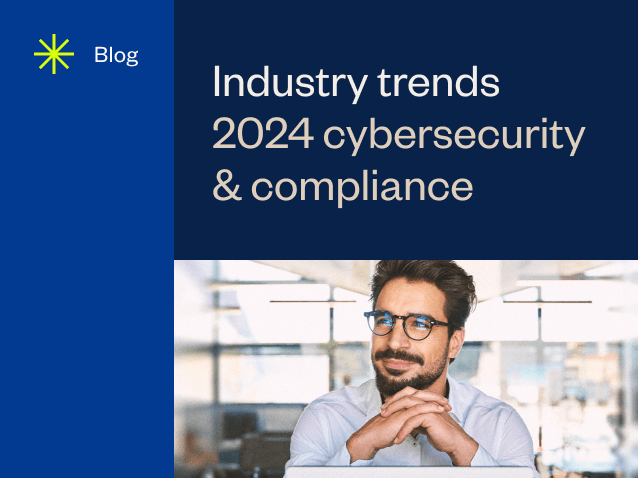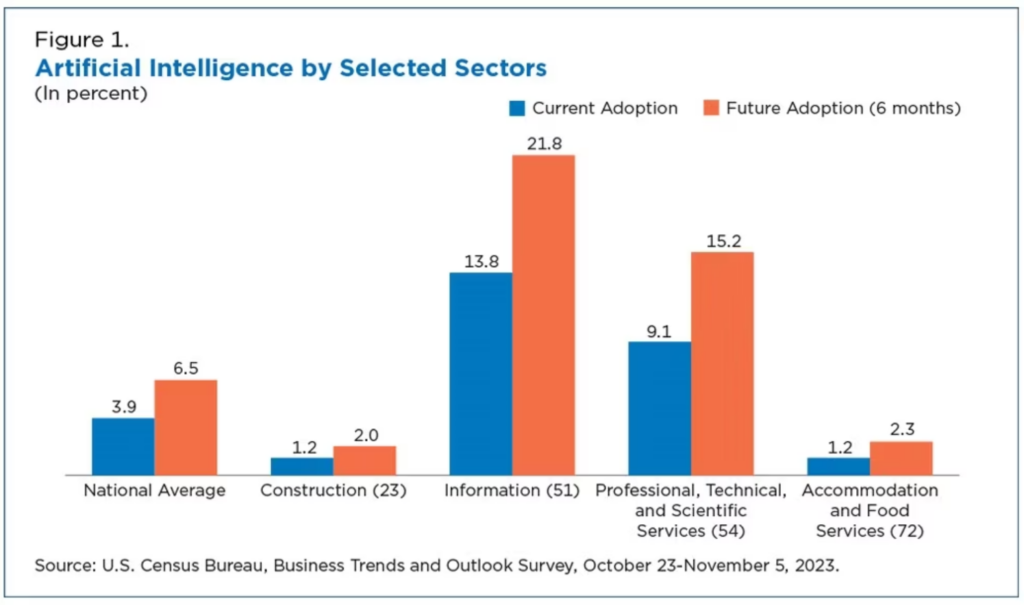2024 Cybersecurity and Compliance Trends

In the ever-evolving landscape of cybersecurity and compliance, staying ahead of the curve has become imperative for businesses worldwide. As technology advances, so do the methods employed by bad actors seeking to exploit vulnerabilities. Recent surveys and reports reveal several notable cybersecurity and compliance trends that businesses should pay attention to.
In this blog, we delve into key trends and strategies that define the current state of cybersecurity and compliance, shedding light on the importance of continuous monitoring, the role of artificial intelligence, and the need for a comprehensive audit strategy.
AI and machine learning gain traction
Artificial intelligence (AI) is revolutionizing how organizations approach cybersecurity and compliance. The U.S. Census Bureau anticipates that the use of AI by businesses to directly produce goods and services will dramatically increase in the first half of 2024, particularly for the information sector and the professional, technical, and scientific services sector. Another recent survey found that 78% of C-suite leaders reported their companies using AI in some capacity.

The increasing use of AI and machine learning (ML) tools enables companies to swiftly analyze vast amounts of data, identifying security risks more efficiently than ever. For example, a team that leverages AI in their security information and event management (SIEM) will build efficiency as AI filters out false positives, enabling the Security Analysts to focus and remediate real threats. Also, AI integrated in firewalls and malware solutions can help automate some controls and save the organization time and money.
The efficiency created by AI tools can make it more practical for businesses to monitor risk proactively, rather than waiting for a major security incident to arise and kick staff into gear. Staying ahead of the curve makes compliance with major security and privacy standards less of a headache because controls are already integrated into regular business operations.
However, using AI and ML for compliance is a double-edged sword that requires vigilance, as malicious actors are also harnessing AI to accelerate hacking attempts. As regulatory bodies adapt — illustrated by the progression of ISO 42001 — organizations must proactively embrace AI while remaining cognizant of the associated risks.
Continuous monitoring wins over point-in-time audits
In the past, compliance was seen as an annual checkpoint activity — something businesses had to do once per year to check a box. But with the threat landscape evolving so rapidly, performing compliance assessments at a single point in time is no longer enough. To safeguard vital company information and avoid catastrophic financial losses, catching potential threats early on is key. According to an IBM report, the global average cost of a data breach in 2023 was $4.45 million, a 15% increase over three years.
Leading organizations are embracing continuous monitoring to regularly validate security controls and compliance with standards. Incorporating regular vulnerability scans and automated attack surface scans ensures that security best practices are implemented across the business throughout the year. This approach is more than a mere checkbox for compliance; it is a commitment to safeguarding sensitive data.
To get a real-time look at compliance within an organization, many cybersecurity teams are turning to software. Depending on the software, organizations can view their current status and potential vulnerabilities, conduct automated scans, track data security metrics, monitor changes in their systems, and more. With the right tools in place, it is easier for teams to see a big picture view of the security landscape and proactively identify threats.
No business is safe from cyber crime
The year 2023 witnessed high-profile cyberattacks that underscored the vulnerability of organizations, regardless of size or industry. Here are a few notable examples:
- MGM Resorts International experienced a cyberattack in September 2023 that it expected would cost the company $100 million. Hackers breached MGM’s systems to steal data for extortion, and the company was forced to shut down some of its systems at its casino resorts across the nation.
- In May, a ransomware group infiltrated Progress Software’s managed file transfer (MFT) solution known as MOVEit Transfer, stealing sensitive data from hundreds of organizations.
Despite these high-profile stories involving massive corporations, 43% of cyberattacks target small businesses, and the average employee of a small business with less than 100 employees will receive 350% more social engineering attacks than an employee of a larger enterprise.
Cybercriminals frequently target startups and smaller organizations specifically because of their lack of security resources. Even businesses with substantial security teams and resources are not immune, raising a crucial question for smaller entities: Can your business withstand a cyberattack?
When it comes to compliance, quality matters
In the Compliance Benchmark Report of 2023, 28% of respondents identified the quality of the final report as the most important factor when selecting cybersecurity and compliance auditors. This underscores the value of audit reports for maintaining compliance and satisfying business partners and to enhance overall IT processes.
Quality is equally crucial for other cybersecurity services such as penetration testing. As the stats we’ve covered illustrate, the difference between a comprehensive cybersecurity program and an inadequate one can add up to millions of dollars in remediation measures and lost revenue. Although the cost of services may be a factor, the focus should be on finding an experienced team that conducts thorough assessments of security controls to help organizations identify vulnerabilities before hackers do. Businesses that value cybersecurity are already making quality a priority.
Audit consolidation improves efficiency and reduces risk
Navigating the audit landscape requires a thoughtful and strategic approach. Spreading out compliance audits throughout the year aligns with the concept of continuous monitoring and helps organizations evaluate threats and vulnerabilities on a regular basis. But because of the ongoing resource requirements involved with cybersecurity and compliance, it’s no surprise that organizations are looking for ways to make the process more efficient. Instead of hiring multiple auditors in an ad hoc fashion, businesses are more frequently opting for audit consolidation with a single, trusted partner.
Constant audits may not sound enjoyable, but if organizations make cybersecurity a priority year-round, compliance will be easy, efficient, and cost-effective. The right compliance partner can help businesses streamline compliance so that a singular audit process will result in multiple assessment reports. That means audits are less of a headache and the business minimizes cyber-related risks — a win-win.
The importance of proactive cybersecurity in 2024 and beyond
The current state of cybersecurity and compliance demands a proactive and adaptive approach. As technology evolves, so do the threats, making continuous monitoring, AI integration, and quality assurance crucial components of a comprehensive strategy. Acknowledging that no business is immune to cyber threats is the first step toward building a resilient defense. By embracing a culture of security, prioritizing quality in audits and cybersecurity measures, and adopting a consolidated and strategic approach to compliance, organizations can navigate the complex landscape and safeguard their digital assets in an era where cybersecurity is more critical than ever.
